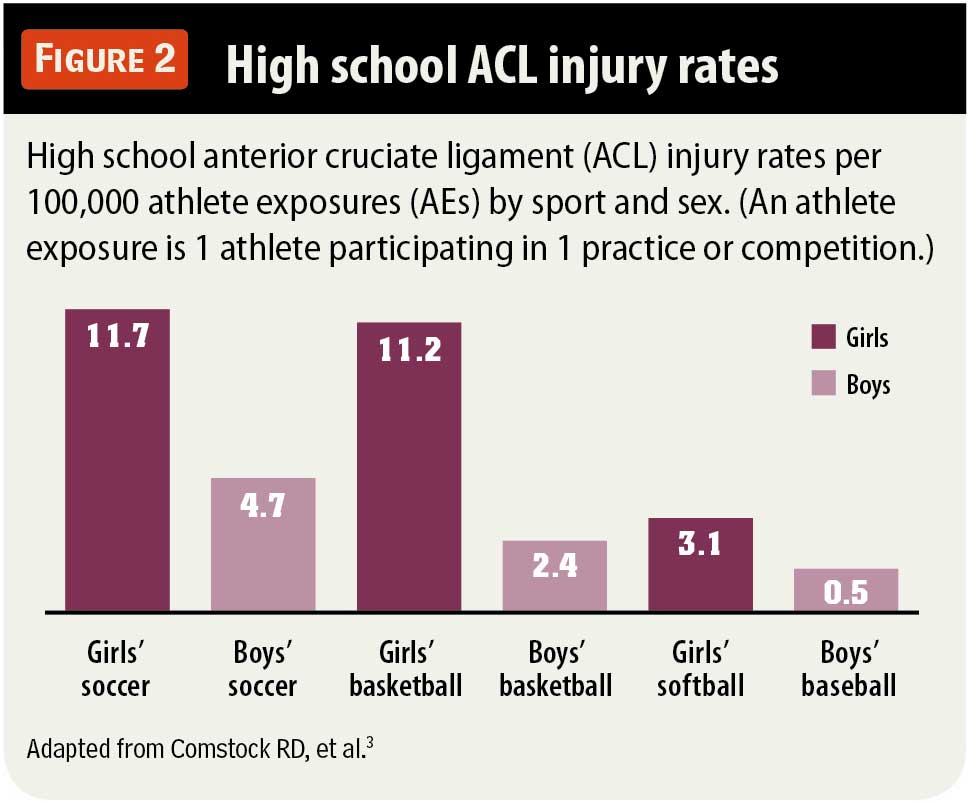ACL injury rates in women athletes have become a critical topic of discussion, especially in light of ongoing sports injury research that highlights the drastic disparities between male and female competitors. Recent studies reveal that female athletes suffer ACL tears at a rate 1.7 times higher than their male counterparts, raising important questions about the factors contributing to these injuries. Common explanations often point to biological reasons, such as hormonal fluctuations or anatomical differences, but emerging research challenges this narrative by emphasizing social factors that impact female athlete injuries. The GenderSci Lab at Harvard is at the forefront of this investigation, advocating for a nuanced understanding of how resource allocation, team dynamics, and training conditions affect ACL injury prevalence in women. To effectively address ACL injury prevention women, it is essential to consider these dimensions rather than relying solely on traditional gender-biased metrics.
In examining the alarming frequency of knee ligament injuries among female athletes, it’s crucial to shift the focus towards understanding the underlying causes beyond just biological risks. The term “anterior cruciate ligament (ACL) injuries in women” refers to the higher incidence of these sports-related injuries that disproportionately affect female competitors. This phenomenon has sparked interest in exploring how sociocultural dynamics and inequities in sports resources contribute to female athlete injuries. Gender sports science continues to play a pivotal role in uncovering the intricate balance of social influences and competitive pressures that may exacerbate the risk of ACL tears. By integrating insights from both biology and social sciences, researchers aim to develop comprehensive strategies for better ACL injury prevention in women.
Understanding the ACL Injury Rates in Women Athletes
ACL injury rates among women athletes have been a growing concern in the field of sports injury research. Studies have highlighted that female athletes face an ACL injury rate approximately 1.7 times higher than their male counterparts. The reasons attributed to this disparity have often revolved around biological factors such as hormonal influences and anatomical differences, particularly concerning the pelvis and knee joint alignment. However, recent insights suggest that these explanations may be overly simplistic and fail to account for the broader context in which women’s sports occur.
The scrutiny of traditional metrics, particularly ‘athlete-exposures,’ reveals significant procedural biases that can skew the understanding of injury prevalence. By focusing solely on the number of athletes multiplied by practices and games, researchers such as Sarah S. Richardson and her colleagues argue that we neglect critical elements, such as the level of competition and infrastructure quality available to female athletes. This oversight has perpetuated the assumption that biological differences are the primary culprit without addressing how social and economic factors also contribute to increased risks.
Social Factors Influencing ACL Injuries in Female Athletes
A comprehensive view of ACL injury rates must include an analysis of social factors that intersect with sports participation. For instance, women often participate in smaller teams, leading to fewer allocated resources, less training, and ultimately greater exposure to injury. The competition structure in women’s sports often results in less overall training compared to male teams, where roster sizes typically allow for more specialized practice. This lack of adequate preparation contributes to heightened injury risks during high-intensity competitions, highlighting the role of environmental factors beyond biological sex.
Moreover, the ongoing underinvestment in women’s sports amplifies the issue. Lower funding means fewer physical therapists or strength and conditioning professionals are available to support female athletes. This not only affects their performance but also limits the access to preventative care needed to reduce ACL injuries. The need for a proactive approach to allocate resources equitably in female sports cannot be overstated, as well-prepared athletes are less prone to injuries, aligning with findings in gender sports science.
The Role of Team Size and Exposure in ACL Injury Rates
Research into ACL injuries has revealed that team size and exposure time directly impact the injury risk women face in sports. The findings from recent studies indicate that a female athlete’s ACL injury risk is considerably higher on smaller teams where competition hours are concentrated among fewer players. While their male counterparts benefit from larger teams, allowing for extended practice without equivalently heightened risks, women athletes are often burdened by a greater share of injury exposure due to their limited participation opportunities.
In sports where injury rates peak during competitions, effectively monitoring training compared to playing time becomes essential in accurately understanding ACL injury rates. To gain insights into injury prevention for female athletes, researchers advocate for a shift in focus towards individual athlete exposure metrics. This could reveal critical touchpoints for intervention, allowing for tailored training regimens that acknowledge the unique challenges posed by smaller team dynamics.
Meticulous Evaluation of Injuries: Shifting Paradigms in Sports Science
As highlighted in new research, reevaluating the methods used to calculate ACL injuries is crucial for developing effective preventative strategies. Current metrics often aggregate data in ways that obscure significant nuances inherent to athletes’ experiences. By adapting assessment techniques to examine individual participation more closely and factoring in social influences, researchers aim to provide more accurate representations of injury risks. This shift in methodology can drastically change how we understand female athlete injuries and their preventative measures.
The call for more nuanced data collection aligns with modern understandings of gender dynamics within sports. As the discussions around ACL injury prevention evolve, there is an increasing recognition that such action is not solely about biological disparities but involves a concerted effort to uplift women’s sports through better resources and training methodologies. Developing clearer metrics can lead to actionable strategies that mitigate injuries while empowering female athletes within their sports.
Enhancing Awareness and Support for Female Athletes’ Health
In light of the rising ACL injury rates among women athletes, raising awareness about these injuries is paramount. Coaches, sports organizations, and medical professionals must proactively educate athletes about the risks involved and the importance of injury prevention strategies tailored for women. This includes promoting proper training techniques, conditioning, and routine assessments that can significantly reduce the likelihood of ACL injuries, thereby ensuring the long-term health of female athletes.
Furthermore, fostering a culture of safety and health within women’s sports can lead to enhanced outcomes in performance and wellness. By addressing the social inequities that have traditionally hindered female athletic participation and preparation, organizations can not only bring recovery protocols to the forefront but also ensure the overall sporting experience is equitable and supportive. Engaging with community-based programs to inform and educate about ACL injury prevention can galvanize change in athlete training practices and resource allocation.
The Future of Gender Analysis in Sports Injury Research
The initiative from Harvard’s GenderSci Lab exemplifies the need for a future-focused approach in sports injury research, particularly concerning ACL injuries in women athletes. By employing gender analyses, researchers can unearth the deeper societal and structural factors influencing injury rates, shifting away from purely biological explanations. Such insights are critical for addressing the unique vulnerabilities faced by female athletes and creating strategies that effectively mitigate risks associated with ACL injuries.
Moreover, interdisciplinary collaboration between gender studies and sports science can foster innovations in understanding all-encompassing factors affecting athlete health. This could include partnerships with policymakers and sports organizations aimed at implementing findings into actionable frameworks that promote equity in women’s sports. Ultimately, enhancing the dialogue around female athlete injuries through comprehensive research can guide future intervention programs, ensuring that athletics become safer and more inclusive for all.
The Impact of Coaching and Training on Female Athlete Injury Prevention
Coaching plays a pivotal role in addressing the higher rates of ACL injuries among women athletes. Coaches are on the frontline, responsible for determining training regimens, drill intensity, and overall athlete wellbeing. Implementing education on injury prevention techniques, such as agility drills and strength training tailored for female body mechanics, can significantly reduce injury risks. It’s imperative that coaching staff not only understand the unique physical demands placed on female athletes but also integrate strategies that are proven to enhance their resilience against injuries.
Additionally, fostering a supportive training environment can empower female athletes, making them more conscious of their health and injury risks. A focus on injury prevention during training periods can not only prepare athletes for the demands of competitive play but also promote a culture of vigilance and care. Coaches can champion this initiative by collaborating with sports health professionals to ensure their athletes receive access to the necessary resources, thereby leading to improved performance outcomes and reduced injury incidence.
Innovative Technologies and Their Role in Injury Prevention
Emerging technologies in sports science are beginning to play a transformative role in ACL injury prevention for women athletes. Wearable devices that measure biomechanics during practice and competition can provide real-time feedback on athletes’ movements, allowing coaches to make necessary adjustments to minimize injury risk. The data garnered from these technologies can provide nuanced insights into an athlete’s condition, helping to better identify when corrective measures are needed.
Moreover, advancements in rehabilitation technology, such as virtual reality simulations and motion capture analysis, offer exciting possibilities for injury recovery and prevention. These innovative tools can create personalized training programs that cater to female athletes, significantly enhancing their ability to recover from injuries and preventing future occurrences. By harnessing these technologies, the landscape of sports injury research can continuously evolve, leading to more effective and personalized strategies for female athletes.
Addressing Social Inequities in Women’s Sports Participation
The conversation surrounding ACL injuries in women athletes cannot occur without addressing the ongoing social inequities in sports participation. Historical and systemic barriers have limited opportunities and resources for female athletes, often leaving them at a heightened risk for injuries like ACL tears. Ensuring equitable access to quality training facilities, professional coaching, and injury prevention programs is crucial to leveling the playing field.
Advocacy for funding and scholarships in women’s sports can play a transformative role in bolstering participation rates and enhancing the training atmosphere. Initiatives that promote girls’ sports programs at grass-roots levels will facilitate greater involvement and provide essential support to develop future generations of female athletes who are informed about injury prevention. Making strides in addressing these disparities will inevitably benefit both individual athlete health and overall sports culture.
Frequently Asked Questions
What are the ACL injury rates in women athletes compared to men?
Research indicates that female athletes experience ACL injury rates 1.7 times higher than their male counterparts. Studies show that while both genders face similar per-unit game time injury rates, the factors contributing to these disparities are complex, including social influences and team structure.
What factors contribute to higher ACL tears among women athletes?
ACL tears in women athletes can be attributed to a blend of factors, including smaller team sizes, differences in training exposure, and social inequities. These structural issues lead to higher competition exposure and can increase the risk of ACL injuries for female athletes.
How does athlete-exposure impact ACL injury rates in female athletes?
The concept of athlete-exposure, which calculates injury risk based on team size and hours of play, may bias the understanding of ACL injury rates. Women athletes often train and compete under different conditions than male athletes, resulting in a possibly inflated perception of their ACL injury risk.
What role do social factors play in female athlete injuries like ACL tears?
Social factors, such as underinvestment in women’s sports and differential access to training resources, contribute significantly to the higher ACL injury rates in women athletes. These elements can lead to disparities in training quality and athlete exposure, affecting overall injury incidence.
What measures can be taken to prevent ACL injuries in women athletes?
Preventative measures include examining and improving training and competition conditions, ensuring equitable access to resources like coaching and therapy, and adopting refined metrics for assessing ACL injury risks. Tailored training programs that focus on conditioning and injury prevention can also help reduce these rates.
Why is there a need for better data on ACL injuries in women athletes?
Accurate data is essential for understanding the root causes of ACL injuries among women athletes. Improved data collection on individual athlete exposure and training conditions can help identify specific risks and support targeted interventions to enhance safety and performance.
What interventions could reduce ACL injury rates in female athletes?
Interventions could encompass customized training regimens that emphasize injury prevention, equitable resource allocation for women’s teams, and systematic research into the social determinants affecting ACL injury risks. This holistic approach can help mitigate injury rates effectively.
How do hormonal and physiological differences affect ACL injuries in women athletes?
While hormonal and anatomical factors have been suggested as reasons for higher ACL injury rates in women, recent research emphasizes the importance of social and structural conditions that contribute more significantly to these injuries. Thus, focusing solely on biological differences can overlook critical avenues for injury prevention.
What is the importance of a comprehensive approach to understanding ACL injuries in women athletes?
Understanding ACL injuries in women athletes requires a comprehensive approach that considers both physiological and social factors. This perspective helps generate more effective injury prevention strategies by addressing the unique challenges faced by female athletes in sports environments.
| Aspect | Men | Women |
|---|---|---|
| Roster size-based Athlete Exposure (AEs) | 28 | 25 |
| Participant-based AEs | 19 | 17 |
| Player-hours | 6 | 6 |
| Injury rate per 100 roster-based AEs | 3.6 | 4.0 |
| Injury rate per 100 participant-based AEs | 5.3 | 5.9 |
| Injury rate per 100 player-hours | 16.7 | 16.7 |
| Injury risk per team member | 0.036 | 0.040 |
| Injury risk per participant | 0.053 | 0.059 |
Summary
ACL injury rates in women athletes are notably higher due to a complex interplay of social factors and biological considerations. Recent research indicates that interpreting these statistics solely through a biological lens is insufficient. Increased injury rates can largely be attributed to biases in traditional metrics that overlook the unique circumstances of women’s sports, such as smaller team sizes and lower training loads. By recognizing and addressing the social and structural factors contributing to these disparities, stakeholders in women’s athletics can develop targeted interventions to enhance athlete safety and performance.



